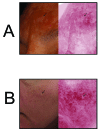Confetti-like Sparing: A Diagnostic Clinical Feature of Melasma
- PMID: 27047632
- PMCID: PMC4771390
Confetti-like Sparing: A Diagnostic Clinical Feature of Melasma
Abstract
Diagnostic uncertainty when a patient presents with melasma-like Undings can lead to suboptimal treatment and inaccurate prognostic expectations. In this study, the authors present a unique clinical feature of melasma that they term the "Fitzpatrick macule" and test its Utility in establishing diagnostic certainty. The "Fitzpatrick macule" is a confetti-like macule of regularly pigmented skin located within a larger patch of melasma hyperpigmentation. To test its diagnostic Utility, the authors compared clinical photography of known cases of melasma with common mimickers, such as poikiloderma of Civatte and solar lentiginosis, and determined the positivity rate of the Fitzpatrick macule in each scenario. Their results show that 89.1 percent of clinical photographs of melasma were positive for the presence of Fitzpatrick macules compared to 1.1 percent that were negative. In contrast, 37.5 and 56.3 percent of clinical photographs of poikiloderma of Civatte were positive and negative for Fitzpatrick macules, respectively. Solar lentiginosis showed a 5.6 percent positivity and a 77.8 percent negativity for Fitzpatrick macules. The sensitivity and specificity of Fitzpatrick macules for melasma was 99 and 83 percent, respectively. In summary, the authors report a highly sensitive and specific clinical feature of melasma. In cases of diagnostic uncertainty, the presence of Fitzpatrick macules may aid in establishing a diagnosis of melasma.
Figures





References
-
- Sheth VM, Pandya AG. Melasma: a comprehensive update: part I. J Am Acad Dermatol. 2011;65:689–697. quiz 98. - PubMed
-
- Werlinger KD, Guevara IL, Gonzalez CM, et al. Prevalence of self-diagnosed melasma among premenopausal Latino women in Dallas and Fort Worth, Texas. Arch Dermatol. 2007;143:424–425. - PubMed
-
- Ball Arefiev KL, Hantash BM. Advances in the treatment ofmelasma: a review of the recent literature. Dermatol Surg. 2012;38:971–984. - PubMed
-
- Sheth VM, Pandya AG. Melasma: a comprehensive update: part II. J Am Acori Dermatol. 2011;65:699–714. quiz 15. - PubMed
-
- Rajaratnam R, Halpern J, Salim A, Emmett C. Interventions for melasma. Cochrane Database Syst Rev. 2010 CD003583. - PubMed
Publication types
LinkOut - more resources
Full Text Sources
Other Literature Sources
Medical
